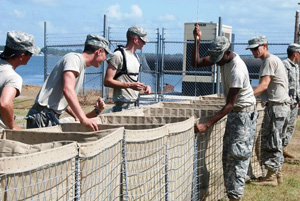Sometime this weekend, the Mississippi River’s flow at the Red River Landing in Louisiana is expected to reach 1.5 million cubic feet per second, the trigger for the U.S. Army Corps of Engineers to open the Morganza Floodway, which has the capacity to divert 600,000 cfs.

Operating the floodway could send 5 to +25 ft of floodwater across 3 million acres of farmlands and residences. But the Corps predicts that not opening the control structure could potentially result in river levee failures and overtopping from north of Baton Rouge to the Gulf, and widespread flooding, including up to 40 ft, in some areas of New Orleans.
By Thursday, May 12, the flow at Red River was 1.42 million cfs, up from 1.39 million cfs the day before, says John Bivona, the New Orleans District’s deputy chief of engineering. On Friday, May 13, the flow reached 1.45 million cfs.
“While there is no official decision made yet, we are keeping our eye on the forecast and using every tool at our disposal to keep people protected and make sure the system performs as it was designed to,” says Mike Petersen, a Corps public affairs specialist who is on loan to the Corps’ Mississippi Valley Division in Vicksburg, Miss., for the flood fight.
While the Morganza Floodway is a key component, it is only one piece of the overall, Mississippi River & Tributaries System, or MR&T, that was designed after the 1927 flood. “It’s important to remember that this decision is not just this one decision. It’s about the whole system, operation of which is outlined in the Water Control Manual,” Petersen says.
The decision to operate Morganza, as well as other control structures in the MR&T, is the responsibility of the Mississippi River Commission President, Maj. Gen.
Michael Walsh, commander of the Mississippi Valley Division.
Walsh already ordered the blasting of a levee on May 2, to divert water and relieve pressure on the levees at Cairo, Illinois. That decision opened the Birds Point/New Madrid Floodway when the Mississippi reached prescribed levels there. Walsh also ordered the May 9 opening of the Bonnet Carré Spillway near New Orleans.
By close of business on May 12, the Corps had opened 223 of 350 gate bays, or 64%, of the 250,000-cfs-capacity Bonnet Carré Spillway. “Our intent is to fully open Bonnet Carré, but it’s a gradual open because of the water control manual guidelines to maintain that +17 levels in New Orleans,” Bivona says.
If the cfs meets the trigger point to open the Morganza Floodway, it will be the first time the structure has been operated for its designed use as a floodway since it was constructed in 1954. In 1973, 42 of the structure’s 125 bays were opened and passed 194,000 cfs (or 32% capacity) to alleviate distress on another facility, the Old River Control Structure. That was rebuilt in 1973, to assist in maintaining the mandated, 70/30 flow distribution between the Mississippi and Atchafalaya Rivers.
The Morganza structure, like all MR&T structures, is subject to inspections every two to three years, Bivona says. Once Walsh gives the order to open the floodway, the 28-ft. wide, steel lift gate bays will be opened using a crane.
On May 6, the Corps released a series of inundation maps, outlining possible scenarios with the Morganza Floodway operating at 50% capacity, zero capacity, and with water being diverted through the Old River Control structure but not through the Morganza Floodway. All three scenarios depicted assume that the Bonnet Carré Spillway is operating at 100% capacity.



Post a comment to this article
Report Abusive Comment